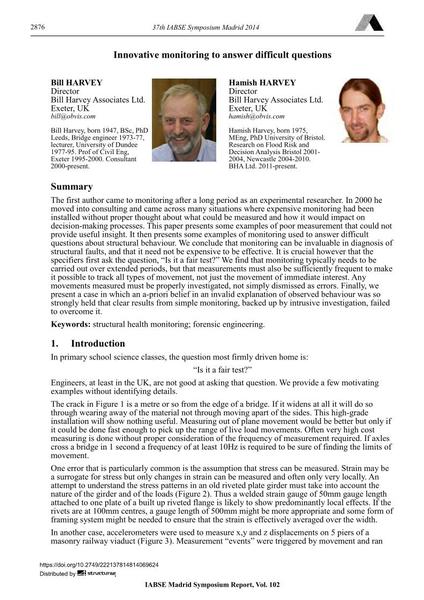Innovative monitoring to answer difficult questions

|
|
|||||||||||
Bibliographic Details
| Author(s): |
Bill Harvey
Hamish Harvey |
||||
|---|---|---|---|---|---|
| Medium: | conference paper | ||||
| Language(s): | English | ||||
| Conference: | IABSE Symposium: Engineering for Progress, Nature and People, Madrid, Spain, 3-5 September 2014 | ||||
| Published in: | IABSE Symposium Madrid 2014 | ||||
|
|||||
| Page(s): | 2876-2883 | ||||
| Total no. of pages: | 8 | ||||
| Year: | 2014 | ||||
| DOI: | 10.2749/222137814814069624 | ||||
| Abstract: |
The first author came to monitoring after a long period as an experimental researcher. In 2000 he moved into consulting and came across many situations where expensive monitoring had been installed without proper thought about what could be measured and how it would impact on decision-making processes. This paper presents some examples of poor measurement that could not provide useful insight. It then presents some examples of monitoring used to answer difficult questions about structural behaviour. We conclude that monitoring can be invaluable in diagnosis of structural faults, and that it need not be expensive to be effective. It is crucial however that the specifiers first ask the question, “Is it a fair test?” We find that monitoring typically needs to be carried out over extended periods, but that measurements must also be sufficiently frequent to make it possible to track all types of movement, not just the movement of immediate interest. Any movements measured must be properly investigated, not simply dismissed as errors. Finally, we present a case in which an a-priori belief in an invalid explanation of observed behaviour was so strongly held that clear results from simple monitoring, backed up by intrusive investigation, failed to overcome it. |
||||
| Keywords: |
forensic engineering structural health monitoring
|
||||
